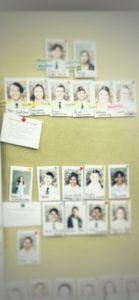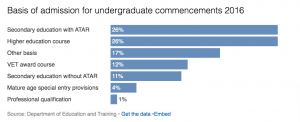I caught up with a friend on the weekend – one of the brightest men that I know. He’s a problem solver and I’ve never seen something that he’s come across that he was stuck by. He would be, in my mind, one of the most employable people I know. Unfortunately, he’s now in his 50’s and facing down a potential job change due to COVID – while the business that he works for is now 160% greater revenues than pre-COVID, they’ve realised that they don’t need quite so many staff now.
It was hard listening to this man that I really like and respect so much say “theres’ not much that I can do because I’ve never gotten a degree”. I reflected the difference in opportunity that he and I had – I was the first in my family to go to university, or even to (so far as I know) consider it. My friend wasn’t in the position to go to uni. He got a trade straight from school and had to continue to work as he was not living with parents at home – and it was the 90’s, where university was seen as the direction for the few – at least those from the western suburbs.
Back then, the leaving age was 15- when my husband and my brother and sister left school. I can’t imagine the 15 year old that I have in my household going out and getting a job and a license, let alone having the maturity to go out and start a career. How much direction was given to students at that age? I know I was handed the UAC guide and the TAFE guide and told to enrol in one. I randomly picked teaching thinking “Eh…I could do that…and I get to wear jeans” against the clear advice of my parents, who wondered how I could ever get up in front of a classroom and speak. It’s a sliding door moment….I remember flicking through the UAC guide and putting in different options that I thought “Wouldn’t be too bad”. There wasn’t much advice coming from school. They were too busy managing fire bombing, drugs and smoking out the back of the library.
Since 2010, the school leaving age was lifted to 17. Two full years older. This of course, reduced unemployment numbers, but was also in recognition of research that says that the longer you are educated for, the more that you end up earning long term. Even a year makes a difference. I would argue though, only if it’s the right year in the right place.
How have schools adapted to increased students? Additional VET Courses, which sits on a higher level of the AQF than the HSC, and requires 1200 hours for a 2 unit course, in addition to the highly specialised equipment, materials and tooling specifications for each course (at the cost to the school/system)
So, as we come up to the time when students are making their life choices, how can we help them to have the most possible options open to them? How can we have them avoid the “I’ve been working 30 years and have no where to go” from my brilliant friend or the “Ive fallen into this pathway” of my own choices. Don’t get me wrong – I consider myself extremely blessed to have “fallen” the direction that I did and I love what I do – but it could have looked so much differently.
One of the things we are doing at St Luke’s is trying to bring prominence to different pathways. In a place where “Learning = Infinite possibilities” how do we ensure that every student is able to work towards a post school life of success and contentment?

This year, we have our first year 11 cohort and are working to ensure that each of
them have engaged in some element of their future prior to leaving year 12. Essentially, a HSC “And….” Keeping this in the forefront of people’s minds and ensuring that our focus is on more than just the number of band 6’s and the great search in December of the schools’ success rate – we have developed a data wall around post school pathways.
Our first level is Post- School Pathways Engaged. These ares students who:
Students
- have an understanding of themselves and their strengths, interests and motivations
- are engaged in school and completing work
- have an understanding of themselves and their pathway to future
- know where their next step lies
- have engaged in some activity/course that puts them on the pathway to this next step
At the moment, out of our (small) cohort of 35 students we have 8 students at this level. We have:
- 4 students engaging in diploma level work while at school getting a HSC
- 1 student completing a TAFE course in Allied Health
- A student who is obtaining a traineeship at our CELC, while obtaining a CERTIII in Early Childhood and a CERT iI in hospitality and a HSC through studying just these subjects, English and Religion
- 2 Students who are doing a work placement with our IT department and Microsoft Industry Level micro credentials as part of this.
Our next level is Post School Pathways Prepared:
Students at this level:
- have an understanding of themselves and their strengths, interests and motivations
- are engaged in school and completing work
- have an understanding of themselves and their pathway to future
Next, Students who are School Engaged:
- have an understanding of themselves and their strengths, interests and motivations
- are engaged in school and completing work
And finally, those students who are not meeting that level. The intent is to move everyone up to a position where they are Post school pathways engaged – engaging in opportunities that will support them once they leave school. This will obviously look different for every student, and may be engagement in courses, portfolios of work, microcredentials, work experience, or professional practice.
Every day for the past four – five years I’ve walked past our “Learning = Infinite Possibilities” sign. First, behind the front desk of the demountable, to then across the concrete wall that every student walks past at least once a day. Wouldn’t it be good if this was true for every student? That there were infinite possibilities that came from knowing themselves deeply and in building their own opportunities and possibilities.



